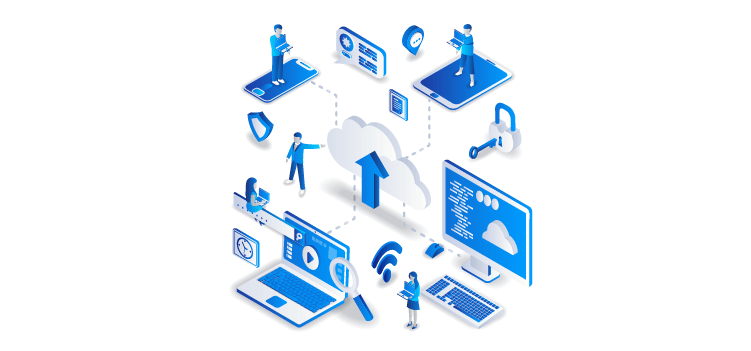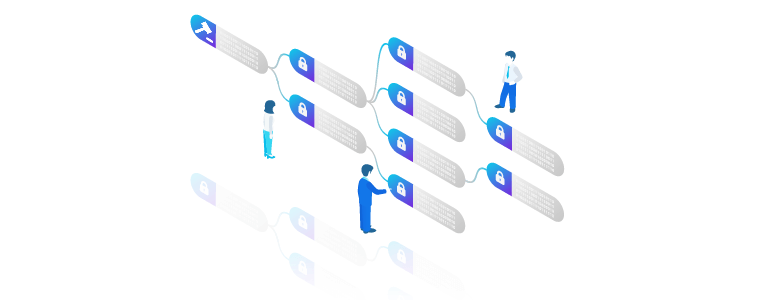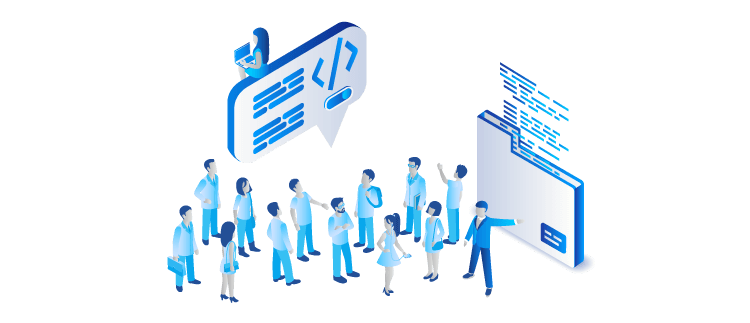This blog post was originally published on 6th June, 2018.
According to Gartner, who are recognized as having coined the phrase, “A citizen developer is a user who creates new business applications for consumption by others using development and runtime environments sanctioned by corporate IT.” At its core, the citizen developer is someone who steps in to solve a business problem.
The concept of the “citizen developer” has been around for quite some time, with business users searching for new ways to manipulate OOTB solutions. For example, I remember back in the early 1990’s leveraging the macros within Excel to import datasets and automate the creation of tables and graphs within our documentation, greatly reducing the time it took to produce them individually. However, we’re hearing more and more about this concept due to the increased availability of cloud-based solutions and low-code tools and scripting capabilities being marketed to non-developers.
The idea behind the citizen developer movement is to leverage no or low-code solutions to create self-service solutions. Where IT has historically been a blocking factor for end users and project teams to get much needed functionality, this new approach moves that traditional IT role into more of an infrastructure or platform-as-a-service (IaaS/PaaS) provider, allowing IT (while still managing the company’s security and compliance needs in relation to them) to provide the data and tools to employees, who could then go in and leverage the components needed to solve their unique business needs. As a result, just about anyone with an understanding of these tools and their business requirements can develop business apps and call themselves a ‘citizen developer’.
Read about the current thoughts on citizen development in SharePoint and Office 365.
Microsoft Corporate VP James Phillips made the case for the citizen developer, stating:
Every organization faces constant pressure to do more with less. While technology is often key to operating more effectively and efficiently, cost and complexity have often prevented organizations from taking maximum advantage of the potential benefits. The growth of SaaS (software as a service) has lowered barriers — no need to deploy servers or to install and configure complex software systems. Just sign up and go. The result? People in departments from sales to marketing, from operations to finance now have the power to select and adopt tools to improve their own processes. And they’re not slowing down to ask for permission.
Arguably, the focus on “digital transformation” and our ability to leverage all that our technology has to offer, has made the focus on citizen development an increasingly important part of the modern enterprise. Historically, a company’s IT department or personnel would purchase and support various hardware and software solutions, deploying platforms and solutions on behalf of the entire company, but also providing the expertise to build out and support team-based and individual-focused solutions and reports, as needed. In otherwise, technology was a centralized activity. For the first half of my career, this traditional view of technology was the mainstream. But the steady move toward the cloud, the rise of bring-your-own-device (BYOD) policies, and the consumerization of formerly complex technology has allowed just about anyone to sign up for a new tool or service in the cloud — in many cases outside of the purview of IT — and get immediate value.

The Difference Between IT Pro and Citizen Developer
Historically, the traditional tasks of the IT Pro have centered around configuration and administration, from provisioning new environments and performance tuning, and from security and compliance monitoring to backup and recovery tasks. What is changing is the scope at which this is done for an organization, where many of these activities are abstracted to a higher level. Many of the app-level controls are managed at the service-level, either through streamlined browser-based controls or as part of solution service level agreements (SLAs) that can be managed by the end user themselves.
A couple years back, MVP John White (@diverdown1964) shared another way to look at the differences of key roles within the changing IT landscape, referring to the differences between developers, IT Pros, and citizen developers in construction terms, which I think works really well:
- Developers are the general contractors, clearing the land for construction, and throughout the building process, responsible for the foundational tasks.
- IT Pros are the architects, designing the structure and ensuring that permits are in place, the build process follows the blueprints, and that everything is up to code.
- Citizen Developers are the designers and decorators, that take what has been built and make it fit into the unique (and constantly changing) needs of the current or future residents.
While the focus of the rest of this article is really on the citizen developer, I do think it is important to include in this dialog how the IT Pro role is evolving. The IT Pro role does not go away, but it does need to change to adjust to the new realities of the technology landscape. For example, the citizen developer likely will not understand the connectivity issues with the various cloud services they leverage, or the nuances of accessing the business apps they create through different devices. There will remain the need to manage identity, devices, security and compliance, internally deployed (whether on-prem, private cloud, or public cloud) and outsourced services and vendors, and any issues that will inevitably arise around architecture, accessibility, integration, and extensibility — working closely with devs and end users alike to ensure that the business has everything it needs to be successful.
SharePoint and the Citizen Developer
Turning to SharePoint, clearly this is one workload that understands the citizen developer movement. One could argue that one of the major factors in SharePoint’s overwhelming success over the past 20 years has been its ability to wrestle control of data, of content, and of entire business solutions out of the control of IT and into the hands of the end user. Arguably, you can map SharePoint’s success back to the Windows SharePoint Services (WSS) days, when many (most?) deployments were happening outside of the purview of the IT team. In fact, during the early days of the platform, a new WSS deployment was typically the result of someone needing to build out capabilities faster than the IT team was able (or willing) to provide, and so they installed SharePoint on their own. Installs started popping up all over the organization as end users needed a solution, and SharePoint provided a way for them to do it themselves.
Even after SharePoint gained widespread adoption — with many IT organizations having to go back and support these rogue, or “shadow IT” installations — many business teams discovered that they could install third-party tools or build simple web parts without corporate IT intervention.
But SharePoint was also instrumental is helping many organizations to re-think their IT approach to many business problems, helping many companies shift the focus toward business owners. The role of the Business Analyst is, in my view, critical to the successful move of any organization toward the citizen developer model. The BA’s core function is to help the organization both streamline business processes, and also to automate the company’s various productivity and collaboration environments, which is the foundation of the citizen developer. A good BA is constantly reviewing critical operations and processes, regularly connecting with the various business units as well as leadership, and holding both technical and business teams accountable for their activities. Without this important role, most IT organizations have a difficult time assessing what their end users truly want and need, and whether what is being delivered is actually meeting customer expectations or business goals.
In a previous post (What is a Customization?), I quote Tony Byrne from Real Story Group when he described our ability to “extend SharePoint, supplement it, or complement it” and how the nature of the platform, throughout its long history, gives Devs, IT Pros, and citizen developers alike the options and flexibility in how they design their systems, allowing this combination of players to customize and configure SharePoint to meet the unique needs of their business. As I state in that post — there is no right or wrong with customizing SharePoint versus creating a business application that leverages SharePoint artifacts (lists, libraries, metadata). The important thing to remember is to build within guidelines of SharePoint and the other workloads (Exchange, Teams, etc).
And while SharePoint remains a critical component of an organization’s collaboration needs, there are a number of new tools and capabilities that are extending the reach of the citizen developer across multiple workloads.
Modern Tools for the Citizen Developer
What are the ‘tools of the trade’ for the citizen developer within the modern enterprise? While Microsoft and many other partners and independent software vendors (ISVs) are creating and extending solutions for the citizen developer, the primary tools (past and present) are as follows:
- PowerApps is one of the latest solutions to help end users leverage SharePoint lists to access, share, and collaborate around their structured data. As its name implies, PowerApps enables citizen developers to create apps that utilize SharePoint lists as a data source. They can also be consumed from a mobile device, or embedded within a SharePoint portal where additional contextual data can be added.
- Microsoft Flow is another new capability that allows users to create business process automation workflows between internal systems and their favorite cloud-based apps and services, providing notifications, helping to synchronize files, collect data, and more.
It’s worth noting that the fastest growing areas within Microsoft’s many different productivity solutions have been PowerApps and Flow, helping to expand the concept of the “citizen developer” within the enterprise through the creation of business apps. By providing templates that end users can leverage to build custom software-as-a-service (SaaS) applications, and the ability to build simple workflow applications with if-then scenarios, Microsoft is ushering in “the era of the business app” — and it’s having a huge impact by helping companies deliver more personalized and granular solutions for their end users. But back to the list…
- Microsoft Forms enable business users to gather information from both internal and external users through surveys, quizzes and polls, and by adding business logic and branching, allowing them to capture a variety of response types — and review the analytics in real-time.
- Power BI allows business users to create powerful reports and dashboards, using data from over 200 different systems, and displaying it within the PowerBI Portal, via mobile app, or in various locations within Office 365.
- Modern Lists allow business users to collaborate in an even more productive way with features such as conditional formatting, bulk editing with Quick Edit, integration with Flow, and much more.
- The SharePoint Framework (SPFx) is a page and web part model supporting client-side development, open source tools, and integration with SharePoint data. It allows developers to use the modern web technologies and tools that they are familiar with, creating apps that are responsive and mobile-ready.
- InfoPath was (and still is for many) a core tool within the citizen developer tool belt. It is a software application for designing and distributing electronic forms containing structured data. Released way back in the 2003 era, it featured a WYSIWYG form designer through which you could add various controls (e.g. textbox, radio Button, checkbox) are connect them to your data. While support was discontinued, it continues to be a fan favorite for many.
- SharePoint Designer (SPD) was a descendant of Microsoft’s FrontPage, and while for years it caused more headaches than solutions, it matured somewhat and became the de facto solution for designing and customizing SharePoint websites and offered a number of SharePoint-specific site templates. Microsoft Flow replaces SharePoint Designer Workflows for SharePoint Workflows, but adds much more functionality. While SharePoint 2010/2013 workflows created with SharePoint Designer are still supported, Microsoft recommends using Microsoft Flow for all your new business process automation needs.
It’s also worth mentioning that third-party solutions have long filled many of the gaps within the SharePoint platform, from small web part providers adding missing functionality, to comprehensive migration, management, and business process management solutions that helped make SharePoint a scalable, enterprise-ready platform. Many of these solutions help drive the customization and personalization movement within the SharePoint community that has helped drive the citizen developer movement within the Microsoft ecosystem. Not only that, but you could argue that if not for the support of the partner ecosystem and healthy citizen developer community around the SharePoint platform, it may not have achieved quite the success.
Supporting Your Citizen Developers
In a ZDNet article a couple years back from long-time writer and industry expert Dion Hinchcliffe, he wrote about the new wave of “grassroots apps that solve long-neglected problems in the enterprise” that can be mastered with little to no technical experience, and which are driving this citizen developer movement at-large. But what really stood out to me about his article was the “typical process” that he outlined, which provides a great example of how the interactions between IT and citizen developer may look within the modern enterprise.
In my mind, the business value of supporting your citizen developers is clear: reduced IT operational expenses, increased speed at which individuals and teams can create self-service solutions, increased personalization and, arguably, improved quality of the solutions created. The goal of this approach is to deliver an environment that better meets the needs of your end users, but in a well-managed — and dare I say “well-governed” — manner that is flexible, secure, and compliant. And that’s the real key to a successful citizen development model: staying within the constraints of your organizational security and compliance requirements, and providing measurable value to your business.

As the needs of your business and end users evolve, citizen developers are better able than a centralized IT team to make ongoing improvements to their applications when and where needed. themselves. Of course, organizations will still need their Dev and IT Pro functions, as there will also be changes to the underlying platforms and services that citizen developers work with on a daily basis.
With the growth of Office 365, Microsoft has clearly been pushing toward more comprehensive, out-of-the-box capabilities rather than requiring companies to configure and customize SharePoint and other workloads to make the platform functional for their specific business requirements. While most organizations want to retain some degree of control over the solutions they provide to their end users — which will keep IT Pros and Devs busy — one truth of the modern enterprise is that the number of people maintaining the back-end is decreasing, and the demand for more skills on the front-end work is increasing.
One last link to share on this topic — there’s a great article on the Hyperfish blog (recently acquired by LiveTiles) by Jeremy Thake (@jthake) that expands on this topic. It includes interviews with well-known MVPs Mark Rackley, Eric Shupps, and Andrew Connell, as well as a podcast with Microsoft’s Chris McNulty, who owns much of the citizen developer story with the SharePoint product team.
Over to you!
There’s now a solution to SharePoint customization governance and security in the cloud which detects any changes made by developers, citizen developers or business users. Check out Rencore for Production under the Rencore Platform. It keeps your environment healthy and secure and your data and information where it is supposed to be – in your hands. Click the button below and schedule a demo today!





